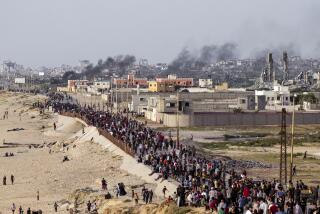Weaving Soviets Into Gulf Units Would Pose Questions for U.S. : Control: American military leaders wonder whether they can form a joint command structure and still be free to act unilaterally if they choose.
- Share via
WASHINGTON — The prospect of U.S. and Soviet soldiers serving together in the Saudi Arabian desert to deter Iraqi aggression offers a powerful symbol of a radically changed world.
U.S. officials, speaking loftily of replacing decades-old military competition with cooperation against a common enemy, say that President Bush intends to ask Soviet President Mikhail S. Gorbachev to send ground troops to serve alongside American servicemen in the growing multinational force arrayed against Iraq.
Yet the plan presents a difficult dilemma for U.S. military leaders: How can they weave the Soviets and two dozen other nations into a joint command structure while leaving the United States free to act unilaterally if it chooses?
The Soviets have said that they will commit forces to the region only under a U.N. command, a proposal that the United States so far has rejected as unworkable.
“Just to slap together a force and put it into an area and in effect put American forces under another commander . . . would be a difficult proposition for us to accept,” Defense Secretary Dick Cheney said this week.
Other government officials acknowledged that there is no current plan to integrate the various military units now in place in Saudi Arabia, although some informal arrangements are being devised on the ground. The United States, for example, has promised to “consult” with Saudi leaders before launching any offensive action against Iraq.
Any more elaborate joint command arrangement, involving some or all of the 25 nations that have committed forces to the region, poses much thornier problems.
“We need to walk before we can run,” a senior Administration official, briefing reporters in advance of this weekend’s summit in Helsinki, said Friday.
The official, who insisted on anonymity, said that the Administration would be “very happy” if the Soviets provided ground troops in addition to their small naval presence in the region.
He said that the dispatch of Soviet soldiers would be a useful “demonstration of the multilateralness of the force” hastily patched together after Iraq’s Aug. 2 takeover of Kuwait.
Soviet willingness to participate in the force shows that the longstanding U.S.-Soviet competition for influence in the Middle East has evolved dramatically in the last several years, this policy-maker said, “and therefore I think a cooperative approach is warranted.”
Since the end of World War II, the United States and the Soviet Union never have stood in arms against a common foe. But in the last three years, the superpowers have initiated a broad series of military-to-military contacts, including port calls by warships, observation of each other’s military exercises and numerous high-level exchanges.
But those are a far cry from the possibility of participating in a joint military action, analysts noted.
Secretary of State James A. Baker III earlier this week suggested that the current crisis could give birth to a new security structure for the Middle East, a radical rearranging of regional and major power alliances. But he admitted that he lacks a vision of its shape or a plan for bringing it into being.
The Soviets have said that they would consider sending ground forces to the Middle East if the troops would fall under U.N. command through the world body’s moribund Military Staff Committee. The committee, composed of senior military officers from the five permanent members of the Security Council, has never run a military operation or even a peacekeeping force. During the Korean War, the United Nations created a separate command structure dominated by the United States.
The committee has been given new life in the current crisis, but the navies and most of the ground forces in the region still report to their national commanders and adhere to their own rules of engagement.
Rep. Les Aspin (D-Wis.), chairman of the House Armed Services Committee, said that the Bush Administration, by quickly dismissing a U.N. oversight role for the forces massing in the region, may have missed an opportunity to secure the Soviets’ military participation in enforcing the economic embargo
“The Pentagon, of course, would object vehemently to the notion of putting U.S. personnel under international authority,” Aspin said Friday at a seminar on U.S.-Soviet policy in the Persian Gulf. “I think, however, that the Bush Administration has been shortsighted in its refusal to consider setting up a U.N. command to enforce the embargo. The embargo will make Saddam Hussein back off if he becomes convinced that he is so isolated that he has no choice.
“Active Soviet military participation in a U.N. force might do the trick while even a leak-proof, U.S.-led effort might not,” Aspin added.
Cheney said that he did not, “in principle,” object to participating in a multinational force. But he said that he is uncomfortable with any command structure that might interfere with what he called the “constitutional chain of command,” running from the President down through the defense secretary and the Joint Chiefs of Staff to the commanders in the field.
“It’s risky business any time you commit forces to a situation where they may, in fact, be involved in combat,” Cheney told a gathering Thursday sponsored by the International Institute for Strategic Studies. “We have always managed during the course of the various arrangements that we’ve negotiated around the world . . . to protect and preserve that principle of the flow of the national command authority . . . and I wouldn’t want to give that up.”
More to Read
Sign up for Essential California
The most important California stories and recommendations in your inbox every morning.
You may occasionally receive promotional content from the Los Angeles Times.













